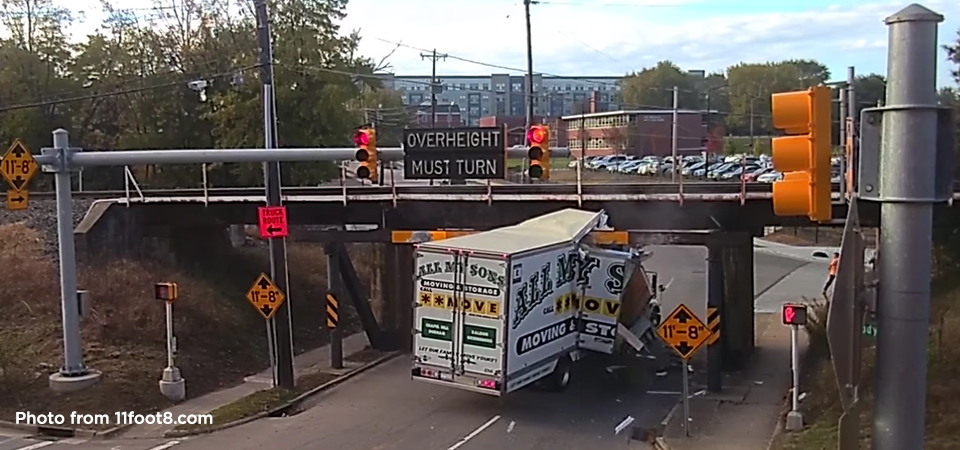Researchers look for ways to prevent railroad overpass crashes
 There is an infamous railroad overpass in North Carolina that gets hit by semis, delivery trucks, and RVs traveling underneath two or three times a month. The overpass and road passing underneath were built around 100 years ago, before vehicles and roads went through cities and standard minimums were enacted. There are hundreds of similar overpasses all over the country that also get hit regularly by vehicles passing underneath.
There is an infamous railroad overpass in North Carolina that gets hit by semis, delivery trucks, and RVs traveling underneath two or three times a month. The overpass and road passing underneath were built around 100 years ago, before vehicles and roads went through cities and standard minimums were enacted. There are hundreds of similar overpasses all over the country that also get hit regularly by vehicles passing underneath.
Using University of New Mexico Center for Advanced Research Computing resources, Professor Fernando Moreu and his team are searching for a way to prevent expensive and risky damage to these overpasses, and have tested one solution in China already, at the Laboratory of Institute of Engineering Mechanics (IEM), China Earthquake Administration (CEA). Moreu is an assistant professor of civil engineering at The University of New Mexico and he also has a courtesy appointment in electrical and computer engineering. He is the director of SMILab, Smart Management of Infrastructure Laboratory, a research group aiming to develop the use of next-generation smart sensing technologies and strategies towards safer, cost-effective, resilient and sustainable structures.
Prior to getting his doctorate degree, Fernando Moreu worked in consulting engineering for over 10 years, mostly focused in structural design and construction of bridges and structures. He is a registered professional engineer. His exposure to both industry, design, and construction informs his research interests and publications. Having worked on multiple railroad bridge projects, Dr. Moreu is well aware that the industry’s first priority is safety.
A video of the “can opener bridge” is good for laughs and groans as the tops of large trucks get scraped off by the overpass, scattering parts and pieces all over the road and vehicles around it. The overpass sports a bright yellow sign and blinking lights, and laser sensors alert drivers that over-height vehicles aren’t going to fit. But for whatever reason, drivers ignore the warnings and the incidents continue regularly at these old bridges.
A lot of the vehicles are driven by professionals but Moreu also cited drivers in unfamiliar vehicles, like people who rent a self-drive truck and don’t know how tall their vehicle is or about height warnings on bridges.
Damaged tracks can mean derailed trains, huge losses of freight, and possible injuries or death for passengers, crews, and nearby motorists and pedestrians.
And time is money, as the saying goes. The $60 billion per year railroad industry moves approximately 40 tons of freight per person over rail track every year. Every time there is an impact, trains need to be stopped, the involved area inspected, and if necessary, the damage fixed quickly so railroad traffic can continue over the bridge. The holdups cost the industry money.
“If you stop train traffic for five hours, it’s going to hurt the consumer,” Moreu noted.
Rebuilding a bridge could cost millions of dollars and can often be more complicated than merely making it a bit higher or digging the road underneath lower. For instance, a sewer system runs only a few inches under the road that passes below the North Carolina bridge. So Moreu and his team set out to find solutions.
On 2016, Moreu collaborated with Sandia National Laboratories in the Non-linear Mechanics and Dynamics Summer Research Institute and designed finite element models of railroad bridges with researchers from China (Professor Bideng Liu, Institute of Disaster Prevention), Denmark (Doctor Anela Bajric, the Technical University of Denmark), and the U.S. (Shreya Vemuganti, UNM) all led by Dr. Ali Ozdagli, postdoctorate fellow working for Moreu. The team wanted to test various scenarios in the search for new designs and remedies.
The group of researchers built virtual models and ran simulations on CARC systems with numerous variations, such as velocity, angle, track size, traffic conditions, and bridge heights. The research takes such a large model and so many complex scenarios, the work can’t be done on regular laptops, Moreu said, and that’s why his group uses the large CARC systems.
The solution they came up with was a crash beam or bumper installed on the bridge. The bumper absorbs and decreases the energy from the impact, reducing the severity of the collision to the bridge and the truck.
“We actually want the bumper to get damaged. To take the energy. Then we replace the bumper and get a new one. The bumper is sacrificial,” Moreu explained. Taking the results, Moreu worked with a group of researchers in China to make a scale model of the bumper and tried it with success in a lab there. The laboratory director in China, Professor Wang Tao, built a 1:5 scale bridge and arranged the testing for the UNM research team in Beijing from November to December 2017.
Professor Guo Xun, dean of the IDP, assisted with the experiment. His student, Xinxing Yuan, is now applying to the Ph.D. program under Moreu at UNM.
The researchers presented preliminary results at the Transportation Research Board Annual Conference in Washington, D.C., last year. Their first journal paper is currently being reviewed and two more journal papers are in preparation.
Moreu hopes to see railroad bridges eventually fitted with bumpers customized for each individual situation that will prevent costly, dangerous damage, and reduce the consequences of sudden collisions, protecting drivers, nearby vehicles, bikers, joggers, pedestrians, and the trains themselves.
In the meantime, the research goes on.
Moreu joked, “We’re hitting bridges in CARC every day and you didn’t know about it. Virtually.”
